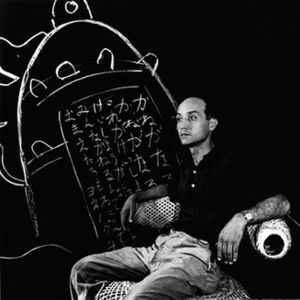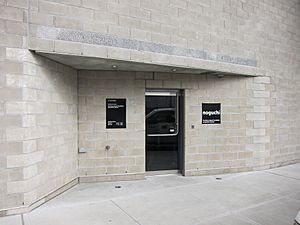Isamu Noguchi facts for kids
Quick facts for kids
Isamu Noguchi
|
|
|---|---|

Isamu Noguchi, 1941
|
|
| Born | November 17, 1904 Los Angeles, California, US
|
| Died | December 30, 1988 (aged 84) New York City, US
|
| Education | Columbia University |
| Known for | Sculpture landscape architecture furniture design |
|
Notable work
|
Red Cube (New York City) Black Sun (Seattle) Sky Gate (Honolulu) Akari lanterns Herman Miller lounge table Sapporo Moerenuma Park |
| Movement | Biomorphism |
| Spouse(s) | |
| Awards | Logan Medal of the arts (Art Institute of Chicago)1963; Gold Medal, Architectural League of New York1965; Brandeis Creative Arts Award, 1966; Gold Medal (American Academy of Arts and Letters), 1977; Order of the Sacred Treasure; National Medal of Arts (1987) |
Isamu Noguchi (野口 勇 (Noguchi Isamu), born November 17, 1904 – died December 30, 1988) was a famous American artist. He was also a landscape architect. His art career lasted for over 60 years, starting in the 1920s.
Noguchi was well-known for his sculptures and public art. He also designed stage sets for Martha Graham's dance shows. Many of his lamps and furniture pieces were mass-produced. Some of these designs are still made and sold today.
In 1947, Noguchi started working with the Herman Miller company. He joined other designers like George Nelson and Charles Eames. Together, they created a collection of modern furniture. This included the famous Noguchi table, which is still made today. You can see his work all over the world. There's also the Isamu Noguchi Foundation and Garden Museum in New York City.
Contents
Isamu Noguchi's Life Story
Early Years (1904–1922)
Isamu Noguchi was born in Los Angeles, California. His father was Yone Noguchi, a Japanese poet. His mother was Léonie Gilmour, an American writer.
When Isamu was young, his mother Léonie took him to Japan. They moved around a lot in Japan. In 1912, his half-sister, Ailes Gilmour, was born. Léonie encouraged Isamu's artistic talent. She had him help with their garden. He also learned from a local carpenter.
In 1918, Isamu was sent back to the United States for school. He went to high school in Indiana. During this time, he was known as "Sam Gilmour." He graduated in 1922.
Becoming an Artist (1922–1927)
After high school, Noguchi wanted to be an artist. He became an apprentice to sculptor Gutzon Borglum. Borglum is famous for Mount Rushmore National Memorial. Noguchi didn't learn much sculpting from Borglum. He mostly helped with tasks like arranging horses for a monument. Borglum even told him he'd never be a sculptor.
Noguchi then went to New York City. He started studying medicine at Columbia University. But he soon met people who encouraged his art. His mother also moved to New York and advised him to take art classes.
In 1924, Noguchi started night classes at the Leonardo da Vinci Art School. The head of the school, Onorio Ruotolo, was very impressed. Just three months later, Noguchi had his first art show. He then left Columbia to become a full-time sculptor. He changed his name from Gilmour to Noguchi.
He started making portrait busts for money. He also saw modern art shows. He was especially interested in the work of Constantin Brâncuși. In 1926, Noguchi won a special grant called a Guggenheim Fellowship. This allowed him to study art in Paris.
Travels and New Ideas (1927–1937)
Noguchi arrived in Paris in 1927. He became an assistant to Constantin Brâncuși for seven months. Brâncuși taught him a lot about stone sculpture. Noguchi also met other artists like Alexander Calder. He created many abstract sculptures during this time.
In 1929, Noguchi returned to New York City. He met Buckminster Fuller, a famous inventor. They worked together on some projects. Noguchi's abstract sculptures from Paris were shown in New York. But none of them sold. So, he went back to making portrait busts to earn money. He sculpted famous people like Martha Graham.
In 1930, Noguchi traveled to Asia. He studied brush painting in China with Qi Baishi. Then he went to Japan. He studied pottery in Kyoto. He was inspired by local Zen gardens and ancient clay figures called haniwa.
When he returned to New York, it was during the Great Depression. It was hard to sell his art. He tried to create large public art designs. But many of his ideas were turned down. One idea was a huge earthwork called Monument to the American Plow. Another was a playground design called Play Mountain.
In 1935, he designed the set for Frontier, a dance show by Martha Graham. This was the first of many stage designs for her. Later, he went to Mexico. There, he designed his first public artwork. It was a large mural for a market in Mexico City. The mural, History as Seen from Mexico in 1936, showed important political and social ideas of the time.
Art and War (1937–1948)
Noguchi returned to New York in 1937. He designed the Zenith Radio Nurse, an early baby monitor. This was his first big industrial design project. He continued to create portrait busts. He also got commissions for two sculptures. One was a fountain for the Ford Motor Company at the 1939 New York World's Fair. The other was a large stainless steel sculpture called News for the Associated Press building.
After the attack on Pearl Harbor in 1941, anti-Japanese feelings grew in the US. Noguchi tried to help Japanese Americans. He joined a group called "Nisei Writers and Artists for Democracy." He hoped to stop the internment of Japanese Americans.
In 1942, Noguchi went to the Poston internment camp in Arizona. He was the only person to go there voluntarily. He wanted to design parks and recreation areas for the camp. But his plans were not used. He found it hard to work with the camp leaders and other internees. He was seen as an outsider.
Noguchi was eventually allowed to leave the camp. The Federal Bureau of Investigation even investigated him. He later shared his experiences in a TV show called The World at War.
Back in New York, Noguchi's art changed. He was influenced by the surrealist movement. He created sculptures with interlocking pieces. One famous work from this time is Kouros.
In 1947, he started working with Herman Miller. This led to many famous designs. These included the Noguchi table, which is a symbol of modern design. He also designed furniture for Knoll. He continued to design sets for Martha Graham's dances.
Later Life and Global Recognition (1948–1988)
In his later years, Noguchi became very famous. He created large sculptures in many major cities around the world.
He was married to Yoshiko Yamaguchi from 1952 to 1957.
In 1955, he designed the sets and costumes for a play called King Lear. In 1962, he became a member of the American Academy of Arts and Letters. He also received the National Medal of Arts in 1987.
Isamu Noguchi passed away on December 30, 1988, at age 84. The New York Times newspaper called him "a versatile and prolific sculptor." They said his art connected Eastern and Western styles.
Important Artworks

- Martha Graham (1929), Honolulu Museum of Art, Hawaii
- Lunar Landscape (1943–44), Crystal Bridges Museum of American Art
- Coffee Table (1944), a famous piece of Mid-century Modern furniture
- Decorative railings for a bridge in Peace Park (1951–1952), Japan
- Gardens for UNESCO, UNESCO Headquarters (1956–1958), Paris, France
- Floor Frame (1962), The White House Rose Garden, Washington, DC
- Sunken Garden for Beinecke Rare Book and Manuscript Library (1960–1964), Yale University
- Billy Rose Sculpture Garden (1960–1965), Israel Museum, Jerusalem
- Red Cube (1968), HSBC Building, New York City
- Octetra (1968), Crystal Bridges Museum of American Art, an abstract concrete sculpture
- Black Sun (1969), Volunteer Park, Seattle, Washington
- Expo '70 Fountains, Osaka, Japan
- Playscapes, Piedmont Park, Atlanta, Georgia (1975–1976), a children's playground
- Sky Gate (1976–1977), Honolulu Hale, Honolulu, Hawaii
- Dodge Fountain (1972–1979) and Philip A. Hart Plaza in Detroit, Michigan
- California Scenario (1980–1982), Noguchi Garden, Costa Mesa, California
- Bolt of Lightning...A Memorial to Benjamin Franklin (installed 1984), Philadelphia, Pennsylvania
- Lillie and Hugh Roy Cullen Sculpture Garden (1986) for the Museum of Fine Arts, Houston, Texas
- Moerenuma Park (2004), Sapporo, Japan
His last project was designing Moerenuma Park in Sapporo, Japan. He designed it in 1988, just before he passed away. The park was finished and opened in 2004.
Honors and Awards
Noguchi received many awards for his art:
- Edward MacDowell Medal for Lifetime Contribution to the Arts (1982)
- National Medal of Arts (1987)
- Order of the Sacred Treasure from the Japanese government (1988)
In 2004, the US Postal Service honored Noguchi with a 37-cent stamp.
Legacy and Museum
The Isamu Noguchi Foundation and Garden Museum works to keep his art safe and share it with the world. It is in New York City.
There was also a special exhibition called "Noguchi for Danh Vo: Counterpoint" at M+ in Hong Kong. It showed Noguchi's work alongside another artist, Danh Vō.
Images for kids
See also
 In Spanish: Isamu Noguchi para niños
In Spanish: Isamu Noguchi para niños
- Wabi-sabi
- Japanese in New York City





